





















































Our omega-3 oil is extensively tested to ensure it is clean of contaminants. Our unique, 100% natural, enteric-coated, softgel capsules protect the omega-3 oil from stomach acid damage and prevent fishy aftertaste.














Omega-3 supports cardiovascular health.
Omega-3 reduces inflammation and is the most e ective in reducing triglycerides and LDL cholesterol.













CEO & Group Publisher • Ryan Benn
Group Vice President, Publishing & Operations • Nina Wagner
Group Content Director, Editor-in-Chief • Tracy Peternell
Managing Editor • Melissa Curman
Senior Editor • Sandi Gauvin
Editor, CNHR • Bruce W. Cole
Editors • Laura Newton, Makena Wardle, Vibha Shukla
Managing Editor, Digital • Colleen Bryon
Digital Assistant • Michelle von Hahn
Group Creative Director & Photographer • Scott Yavis
Art Director, Publications • Iva Zima
Senior Graphic Designers • Lindsay Burke, Alvarro Pastorin
Group Director of Operations • Devin Steinberg
Production Associate • Natasha Jayawardena
Vice President, Sales • Ellen Wheeler
Sales Director • Gaby Sepulveda Knuth
Publisher, Live Naturally • Deborah Juris
Sales Coordinatior, CNHR Advertising • Phileasha Gentry
Retail Account Executive, USA • Rebecca Randolph
Retail Account Executive, Canada • Aaron Alvarez
Group Vice President, Education & Administration • Jane Griffiths
Manager, HR & Administration • Ava Pashmchi
Executive Assistant • Hannah Dewar
Office Administrator • Celine Simpson
Manager, alive Academy • Julia Wagner Manager, Academy Admissions • Jan Clay
Director of Finance • Conroy Ing, CPA, CMA Senior Accountant • Maira Guzman
Accounts Receivable Specialist • Jacqui Harquail
CONTACT INFORMATION
Alive Publishing Group Inc. 100-12751 Vulcan Way, Richmond, BC V6V 3C8 Phone: 604.295.9333 Toll Free: 800.663.6580 Cover price is $5.75. Nine issues published per year. Canada Publications Mail Sales Product Agreement No. 40011604
ADVERTISING POLICY
sage accepts advertising based upon space availability and consistency with its mission to promote a natural health and wellness lifestyle. sage is not responsible for the content of advertisements, the products offered or the viewpoints expressed therein.
EDITORIAL NOTE
The information provided in this magazine is for educational and informational purposes only. It should not be used as a substitute for the advice of a qualified and licensed practitioner or health care provider. The opinions expressed here are not necessarily those of Alive Publishing Group Inc., its affiliates or parent company. Different views may appear in future articles or publications. Articles in sage are copyrighted and must not be reprinted, duplicated or transmitted without permission.
“Edible flowers can also be used in myriad ways to add interest and elegance to dishes.” P. 32
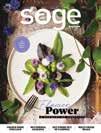
Shutterstock 6-8, 10-23, 26, 31-33,64-66
Pexels 24, 27, 29, 42
Scott Yavis cover, 9, 34, 37, 38, 41, 44 47-48, 51-52, 55-56, 59



WELCOME
There’s something about summer. The sounds and smells envelop us like a warm hug, and everything seems to slow down as we settle into the warmth of the season. We can hear kids playing, smell freshly cut grass, get lost in the blue skies and warm breezes, and enjoy the flowers—bright, fragrant, and full of life. Everything just feels so alive.
This time of year, for many, offers a slower pace and time to relax into long and lazy days, enjoy the outdoors, and play. That’s why, in our summer issue of sage , we’re exploring ways to support your brain to help you focus and enjoy all the summertime vibes!
Part of good brain health is keeping it active and engaged through positive stimulation. With that in mind, we’re exploring multimodal enrichment, a practice that teaches you how to learn with all your senses. And since brain health is just as important for the little ones, you’ll also learn how being present means everything for your child’s mental well-being.
Summer is also a great time to explore. Discover the many facets of camping as we help you rethink this classic summer activity with info on RV camping, backpacking, and s’more!
And because you just can’t beat the taste of summer food, we bring you recipes brimming with the sweet and delicious flavours of summer. Then, we delight your senses with the flavours and beauty of edible flowers and their beautiful bouquet of benefits! Plus, don’t miss a fresh set of recipes that are packed with the vibrant flavour of mint!
Whatever you have in store this summer, we hope you take some time to consciously unwind, relax in a field of grass or on a sandy beach, and just be.
Wishing you continued health and wellness and the opportunity to enjoy those summer vibes!
the team at sage






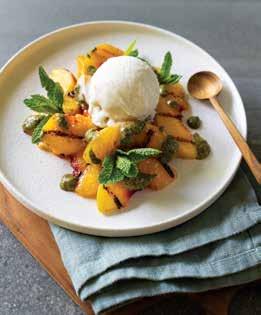

You can add “anti-inflammatory” to the ever-growing list of reasons to include walking in your routine. In fact, one study found that just 20 minutes of walking on a treadmill per day was effective at reducing inflammation.
Inflammation is the body’s way of protecting against different kinds of infection, making it an important bodily function. When the body becomes too inflamed, however, pain and other negative health outcomes may follow.
Walking also lowers stress, another major contributor to inflammation levels. Similarly, walking improves the duration and quality of your sleep, and lowers body weight, which can also help reduce inflammation in the body.
Beginning a walking routine? Be sure to build up your routine slowly as overtraining can inadvertently lead to more inflammation. Alternatively, try other lower impact forms of movement such as swimming, yoga, or tai chi.

Give plant-based sushi a try
If you love the idea of preparing and eating sushi, but prefer to stick to a plant-based diet, the plant-based sushi craze will have you breaking out the chopsticks and grabbing the closest bottle of tamari.
When it comes to making plant-based sushi, the only limit is your imagination. If the texture of sashimi appeals to you, consider substituting seafood with cured tomato, mushroom, or eggplant—try marinating the veggies in a combination of tamari or soy sauce, sake, mirin, neutral oil, and rice vinegar before using to top sticky rice.
To add a vegan source of protein to your sushi rolls, thinly slice firm tofu or tempeh into matchsticks (pre-smoked tofu is also a good option). To complete your plant-based sushi, choose ingredients with contrasting flavours and colours, such as pickled vegetables, grated carrots, and crunchy sesame seeds or nori flakes. Yum!

Detoxing the scalp for a healthier head of hair
If you already track your physical movement and your heart rate using wearable tech—is measuring your quality of sleep next? As it turns out, the answer is complex and will depend on the accuracy of the data you’re hoping to collect.
In its most popular iteration, wearable sleep tech takes the form of a watch/wristband or a ring that can be worn comfortably during sleep. The device then collects data such as wrist movement and heart rate which is then broken down into a graph or another visual display, providing you with data on the quality of your rest.
Because the tech behind these wearables is proprietary, there’s
Scalp detoxing is a form of scalp massage that aims to exfoliate, unclog pores, and remove product buildup from your hair follicles. Like a facial or other spa treatment, a
scalp detox goes beyond basic cleaning and conditioning by incorporating exfoliating products and techniques into the mix.
Who benefits the most from this type of scalp massage?
Anyone who experiences product buildup (which can make hair look dull, heavy, and greasy) or conditions affecting the scalp such as dandruff, psoriasis, or seborrheic dermatitis—also known as cradle cap.
A healthy scalp has been linked to increased hair thickness, growth, and retention. To perform your own scalp detox at home, look for textured scrubs; combs and brushes designed to gently exfoliate the scalp; and chemical exfoliant products such as those containing salicylic acid, coal and wood tar, or zinc pyrithione.

no way for the consumer to know how the collected information is being assessed, compiled, and compared to other data.
So though you may find it helpful to track your sleep, if
you are struggling with poor sleep quality, consider booking a polysomnography test, which accurately measures muscle tone, breathing, heart rate, and brain waves in a clinical setting.
 BY LEAH PAYNE
BY LEAH PAYNE

Is there anything better than the feeling of a clean and organized home? Spring may have already sprung, but summer can also be the perfect season to refresh your surroundings and rejuvenate your mind. With a little planning, we can each find a cleaning routine that feels doable and sustainable for us.
Do you find a messy, cluttered space anxietyinducing? You’re not alone. Research tells us that our environments can have a big impact on our mental health. Visual clutter can make us feel scattered and stressed, while clean and tidy spaces can help put our minds at ease.
Whether your home is seriously messy or just in need of a seasonal spruce-up, the good news is that cleaning and organizing is easier than we think. All we need are a few systems and routines—and a bit of good old-fashioned elbow grease.
But first, a disclaimer: everyone’s homes, families, and schedules are very different. The following routines are suggestions only, and may not work perfectly for you. The trick is to use them as inspiration, and then come up with your own perfectly personalized routine.
The following tasks are all about deep cleaning and organizing—you know, the things you likely don’t have time for on a daily or weekly basis. They’re the things that might sit on your to-do list and bring you grief when you remember them. But no longer!
Depending on your needs and schedule, aim to tackle one task each day, weekend, or week. As you complete these tasks, consider when they should be done next and slot them into your annual, seasonal, or monthly home maintenance checklists.
Take-care
5
1 Keep cleaning products out of reach of children and pets.
2 Never mix cleaning products; some can create dangerous fumes.
3 Always read labels carefully before using a cleaning product.
4 Wear gloves when cleaning.
5
Ventilate by opening windows and turning on fans when cleaning.
“Visual clutter can make us feel scattered and stressed, while clean and tidy spaces can help put our minds at ease.”
One at a time choose a space or category to conquer (books, kitchen drawers, or a coat closet for example).
Take everything out, vacuuming and dusting the insides of drawers and closets.
Think twice about each item before you put it back: do I still need, want, and use this item? Does this item need to be repaired or mended?
Mend clothes and darn socks, take shoes to the cobbler, and fix anything else that needs to be fixed.
When you put items back, try to create a home for everything, so nothing gets misplaced.
Declutter food storage areas such as your pantry, refrigerator, or deep freeze.
Note expiry dates and toss anything that’s unsuitable for consumption.
Check the bathroom and inventory your family’s medicine and supplement cabinet.
Bring expired products to pharmacies for proper disposal.
Stock up on items that need replacing.
Don’t ignore virtual clutter: delete unneeded files, emails, and apps.

10 tidy tips
1
Make a daily to-do list and enjoy the satisfaction of crossing off a task.
2 If the task takes 45 seconds or less, do it immediately rather than putting it off.
3
Set a timer for as long as you have (even if it’s five or 10 minutes) and see how much you can get done.
4
Appliances: give the oven, dishwasher, and washing machine a deep clean, including (carefully!) pulling each away from the wall, where possible, to clean behind it.
Walls: wash walls where needed, along with baseboards and light fixtures.
Rugs and upholstery: have these either professionally cleaned or DIY with rental equipment.
Car: give the car a deep clean both inside and out.
Trash and recycling bins: thoroughly wash inside and outside of each.
Organize and restock home maintenance products such as batteries, air purifier filters, vacuum bags, and light bulbs. Replace what’s needed around the house.
Check smoke and carbon monoxide alarms.
If needed, redo caulking or grout in kitchens and bathrooms.
Have dryer vents professionally cleaned. Change furnace filters.
Clean gutters, patio furniture, windows, window screens, and other exterior fixtures.
Put on your favourite podcast or playlist to make cleaning more fun.
5
Run an air purifier to help reduce indoor dust.
6
Have a “donate” bin always on the go, so you can always add to it.
7
Take your shoes off at the door and wash your hands to keep your floors tidy and your house cleaner.
8
Sanitize your electronic devices regularly to keep them germ free.
9
Make an “eat first” bin in the fridge, to save money, reduce food waste, and stay organized.
10
Don’t worry about being perfect! There’s no such thing.
Now that your home is spic and span, we can turn our sights toward maintenance. Daily cleaning tasks can become so routine that we barely have to think about them. Once we’ve found a rhythm that works for us, they really don’t take much time or energy at all.
MORNING
☐ make the beds
☐ water houseplants
☐ do laundry
☐ refresh towels
DURING THE DAY
☐ pick up/tidy as you go
☐ complete weekly task
EVENING
☐ sort mail
☐ clear surfaces and put items back where they belong
☐ pick up toys
☐ handwash dishes and run dishwasher
☐ wipe kitchen counters and cooktop
☐ take out trash/ compost/recycling
Get the kids involved!
cloths and rags
glass spray bottles
all-purpose
spray cleaner
all-purpose soap (such as Castile soap)
glass cleaner
toilet cleaner
dish soap liquid or block
stain remover bar brushes (dish brushes, toilet brushes, scrub brushes)
drying rack and clothing pegs gloves

Even young children can help clean! Give them age-appropriate tasks, such as sorting laundry, picking up toys, or sweeping with a child-sized broom. This can help normalize cleaning and teach them skills they’ll need all their lives.
Many people enjoy assigning a task, or a room, to each day of the week, to take the guesswork out of cleaning. Here is one example of a weekly schedule.
MONDAY KITCHEN
☐ wipe cupboards, counters, and other surfaces
☐ scrub and disinfect sinks
☐ organize and clean fridge, tossing old food
☐ clean microwave
TUESDAY BATHROOMS
☐ clean towels
☐ clean bathroom counters
☐ clean toilets, bathtubs, and showers
☐ scrub and disinfect sinks
WEDNESDAY FLOORS
☐ mop
☐ vacuum
THURSDAY BEDROOMS
☐ wash bedding and linens
☐ dust surfaces
FRIDAY LIVING ROOM
☐ vacuum carpeting and couch crevices
☐ dust surfaces
SATURDAY MISCELLANEOUS
☐ sweep front entryway/porch
☐ wipe baseboards and dust other areas (entryway or office).
☐ clean windows and mirrors
SUNDAY REST DAY

“The world is your oyster out there. It’s incredibly freeing, and people really come alive.”

RV CAMPING, BACKPACKING, AND S’MORE
BY JOSHUA DUVAUCHELLEOver the past decade, the number of Canadians who camp has risen year after year. Today, camping ranks as one of Canada’s top three most popular outdoor activities. From kayak camping to backpacking, the Canadian wilderness offers an adventure for everyone.
Canada’s 47 national parks and national park reserves provide nearly 340,000 square kilometers of camping possibilities. That doesn’t even include provincial parks, private and commercial campgrounds, and free campsites.
“Canada’s the best for camping because it’s so spacious,” says Alex Ross, a camping guide and the CEO of Fresh Adventures in BC. “Our guests from abroad—even Australia!—can’t believe our vast amount of wilderness and how much space you have to explore.”
Pitching your tent at a city campground has its perks. But it’s far from the only type of camping you can try.
Nearly 60 percent of campers want to try RV camping. A campervan offers a smaller, more maneuverable alternative to RVs. “Van camping is growing in popularity,” says Ross. “It makes things easier for people who want to be more protected from animals, bugs, and bad weather.”
Trek to a remote beach or a distant peak and truly disconnect from our busy, modern world. “In our backpacking trips, we wander past alpine lakes and glaciers,” says Ross. “The world is your oyster out there. We can camp wherever we want. It’s incredibly freeing, and people really come alive.”

Zip along forest service roads or across regional parks—you can cover far more ground than hiking on foot—until you find a camping spot that calls your name.
Pack your waterproof dry bags onto a kayak, canoe, paddleboard, or even jet ski, and explore beaches and coves otherwise inaccessible to others. “We scoot out to the ocean for a couple days, exploring remote, unspoiled inlets,” says Ross.
Camping is good for you: it builds self-confidence, boosts mental health, resets your natural sleep cycle, and can even strengthen your relationships.
Vitamin C(amping)FRONTCOUNTRY
campgrounds are easily accessible by car. They often have basic facilities such as washrooms and even a place to buy firewood.

FRONTCOUNTRY VERSUS BACKCOUNTRY

Permits
Most campgrounds have daily admission and service fees. For national parks, you’ll need a single-location pass or an annual Parks Canada Discovery Pass. They’re available on the Parks Canada website ( parks.canada.ca) or at MEC stores. For other parks, contact your province or the private campground operator.
BACKCOUNTRY sites are more remote. They usually require hiking or a 4x4 vehicle to access them and have few to no amenities, but they are the perfect escape into the wild.
Book your campsite as soon as possible because they fill up fast. Reservations for most parks open in the early spring. National parks can be booked online (reservation.pc.gc.ca) or by calling 1-877-737-3783.
You can camp year-round, but some parks may close various campgrounds or trails during the November to April off-season. Prepare for poorer weather and limited services, but embrace the opportunity to enjoy fewer crowds at your campground.
READY, SET, CAMP!
1 EASE INTO IT IF YOU’RE NEW
Start with a backyard camping trip to practise setting up a tent and using your camping supplies.
“Take baby steps,” says Ross. “Try a frontcountry weekend. After that, go to a walk-in campsite at a provincial park, which will help you get used to packing your backpack and carrying all your gear in one load. Then just go from there!”
“A minimalistic approach saves money, is easier to pack, and makes you more mobile,” says Ross. “Most people overpack drastically—you’re typically fine with a lot less than you think you need.”
Basic must-haves include a tent, sleeping bag, and flashlights or headlamps with extra batteries. You’ll also want a first aid kit, personal hygiene products such as sunscreen, and basic cooking supplies.
3 CONSIDER GUIDED TOURS OR A WORKSHOP
“When I first started, I took guided expeditions and mountaineering courses,” says Ross. “It’s a great way to meet like-minded people, jump right in, and quickly learn from camping experts.
“Before you know it, you’ll be ready to tackle any sort of camping,” says Ross. “I find that as people overcome different camping challenges, they’re excited and prepared for the next one.”

Is there a magic ingredient to parenting that helps children grow up happy, cultivates resiliency, and helps them reach their potential—whatever that may be? Short answer: yes. However, a worthy reminder: do not compare children and their thrive journeys. “Having a sense of achievement means thriving,” says Gail Johnson, Kamloops-based pediatric occupational therapist. “Acknowledging that each child is differently abled allows us to celebrate their unique competencies and facilitate opportunities to succeed.”

“Being present allows us to respond to our children’s needs, help them learn about trust, and cultivate their empathy and resilience.”

From being born helpless, our first years of life are the most impactful for brain development. New neural connections, called synapses, form with each new experience. However, it starts long before that. Building a new brain calls for proper nutrition (and supplementation, where necessary) that ensures adequate levels of folate, iodine, vitamin D, iron, choline, and omega-3 essential fatty acids (essential for brain development). But high stress levels can affect brain development and so can various hormones.
Learning comes in many flavours
If a child has difficulties processing language, explains Gail Johnson, pediatric occupational therapist, they may learn differently. So judgment aside, it may be useful to consult a child development specialist and learn about how to best support your child on their academic journey.
Early infancy is the time for bonding. By holding our babies and attending to their needs, we help them learn to trust us, each interaction cemented by new synapses (over 1 million neural connections are formed in the brain every second during the first few years of life).
Toddler years come with a lot of new learning, including emotions. However, says Johnson, “Some children may have difficulties expressing or understanding emotions, due to developmental issues.”
This can make it difficult to connect emotionally, but that doesn’t hinder communication. “It comes down to being attentive to the other ways they communicate and what they are curious about,” she says.
Closeness comes in many flavours at this age: holding them, snuggling to read, role playing, and exploring outdoors are just some of the ways we can connect and communicate with our kids.
During preschool and school years, children learn about co-operative and competitive play, handling emotions, and developing social skills. Being present allows you to observe and help create opportunities to respond to their needs, including their new need for more independence.
Parenting teenagers has never been easy, and each generation faces new challenges. Preteens become aware of body changes, which increases self-consciousness, more so in the age of social media. There will be bouts of moodiness, self-doubt, passive aggression, and a greater-than-ever need to know their parents are present.
“There’s much rewiring happening during the teenage years, which often makes communication difficult,” says Johnson. Strive to create a positive family environment and offer opportunities to connect over what interests them. Above all, says Johnson, be present, observe, and listen.
Alcohol and drugs can affect the developing brains in myriad ways. Cannabis affects coordination, thinking and decision-making, and mood. Alcohol can impair memory and may cause changes within the brain and between brain regions.
Allowing children to say no early in life helps them learn about boundaries and equips them to better resist peer pressure related to drugs and alcohol during the teenage years. Open the conversation ahead of time and help them come up with a plan such as having supportive peers, leaving when not feeling safe, and even blaming it on their parents, if need be.
Omega-3
essential fatty acids (EPA and DHA)
Supplements may improve ADHD symptoms and enhance memory and verbal skills.
Note: please speak to a health professional prior to starting your child on a supplement.
Vitamin N (nature)
Daily doses improve cognition and brain activity and promote better sleep.
Vitamin S (sleep)
Sufficient sleep (at least nine hours) promotes healthy brain development and better emotional regulation.
Physically active children and teenagers are likely to learn better and enjoy better self-esteem compared to those who are less active. “Movement helps with attention and mood regulation and it’s an opportunity for social connection,” says Johnson.
But it’s not just organized sports that count. Impromptu silly dances, backyard hide-and-seek, hikes, and bike rides all mean movement and connecting with your child. “Engage in something that’s joyful for your children,” says Johnson, “and find ways to pursue activities you like and introduce your children to them.”
Our children’s developmental journeys come with unexpected turns and emotional ups and downs. Being present allows us to respond to our children’s needs, help them learn about trust, and cultivate their empathy and resilience.
It also allows us to grow alongside our children and find grace in the most unexpected places along the way.


“From a young age, it’s important that kids are engaging their senses in their entire bodies.”
How do we learn best? New scientific evidence suggests that learning that incorporates the use of multiple senses and movement—known as multimodal enrichment—may be the way of the future when it comes to teaching and learning for all ages.
Multimodal enrichment (a.k.a. multisensory learning) transforms the traditional classroom into a more natural setting, using all of the sights, sounds, odours, tastes, and proprioceptive information that comes with it. It may engage some—or all—of our senses at once.
There are five different sensory “modes” known to kick learning into hyperdrive: linguistic, visual, audio, gestural, and spatial.
Utilizing one or all of these modes can help enhance learning in multiple skill areas, including letter and vocabulary acquisition, reading, mathematics, music, and spatial navigation.
One of the most longstanding examples of multimodal enrichment is the Montessori method, where the role of hands-on experience with physical objects and specialized learning materials that engage multiple senses is emphasized.
Recent research has found that the mechanisms by which multimodal learning are processed in the brain and produce enhanced learning benefits, explaining why multisensory methods such as Montessori work.
The researchers involved in the new study have great
hopes for the future of multimodal enrichment. They believe their findings may inspire new hypotheses about learning, which will lead to the optimization of learning and teaching strategies in the future, for both humans and artificial systems.
Dr. Bibi Pirayesh, an educational therapist and founder of One of One Educational Therapy, knows first-hand that using your senses is essential to learning for kids with learning disabilities.
“You experience life through all of your senses,” says Pirayesh. “From a young age, it’s important that kids are engaging their senses and their entire bodies in their learning.”
At Peace of Mind Psychological Services in Johns Creek, Georgia, director, speaker, and clinical psychologist Dr. Brianna Gaynor says they begin with the understanding that everyone learns differently.
They help employees identify and then apply the learning style that works best for them. Then, they enable employees to learn in a way suited to them, which means they provide manuals with visuals and meetings for auditory learners, but they also understand that those who learn by doing may have to be shown how to complete a task.
Pirayesh says the type of multisensory method she employs depends on the learner and how they learn best.
“The main principle is that we try to move away from the two-dimensional page when possible, which requires an incredible amount of abstraction,” says Pirayesh.
There are myriad ways to apply the magic of multimodal learning. Here are just some examples.
Physical movement can be integrated into learning in multiple ways. One study found that the use of directional gestures that imitate the trajectories of Mandarin Chinese tones while learning the language can assist with subsequent tone recognition.
Movement is also an important tool for Pirayesh. For instance, she’ll have learners move before sessions to engage the brain: she may have students draw or walk the infinity sign or move across the midline of their bodies by, for example, bringing up their left knee and touching it with their right hand and vice versa.
“This can be challenging for kids who struggle but very helpful to integrate the brain,” says Pirayesh.
In this active learning strategy first introduced by Professor Frank Lyman in 1981, students are given time to think or jot their thoughts down. Then, they’re paired with one other student or a small group to discuss what they just thought about. Lastly, some students are selected to share what they discussed in their pairs or groups.
In this strategy, which refers to the use of real-life examples when introducing or going through a concept in class, the instructor’s role is to facilitate a discussion where the students analyze and problem-solve as a group.
The sky is the limit here. Students can use visuals, props, puppets, dramatic play, video presentations, and so on to demonstrate their understanding of a topic.

Jumpstart your learning journey with these natural learning supports
L-THEANINE
An amino acid found in green tea, L-theanine has been shown to relieve stress disorders, improve mood, and maintain normal sleep. A 2021 study concluded L-theanine may contribute to improved attention, which may help enhance working memory and executive functions.
GREEN TEA/MATCHA
A 2020 study concluded green tea consumption may be linked to better cognitive function, in particular in memory and executive function.
OMEGA-3
Linked to better neurological outcomes in older adults, the exploratory results of a 2022 study found a higher omega-3 index to be associated with better abstract reasoning and larger hippocampal volumes in middle-aged adults.
VITAMIN E
Some research has demonstrated that high-dose vitamin E may delay the progression of Alzheimer’s disease, although further research is needed to determine its long-term safety and efficacy.
“There are five different sensory ‘modes’ known to kick learning into hyperdrive: linguistic, visual, audio, gestural, and spatial.”
The active ingredient in turmeric, curcumin may help improve brain function and manage dementia. It has also been found helpful in managing a variety of chronic inflammatory conditions and lowering cardiovascular disease risk.















Tune in with care
Experts agree that listening to colour noise is completely safe as long as—like with all music—you don’t listen to it too loudly. Listening to anything above 70 decibels for a prolonged period can damage your hearing.
Every December, millennials like me look forward to seeing their yearly music listening preferences “wrapped” on a popular music streaming app. We share our top five most-listened-to songs on social media, with the idea that our favourite music says something about the kind of person we are.
Imagine my surprise when one year, my most-played song wasn’t a song at all, but a three-hour track of … white noise. And then imagine having to explain to friends why I wouldn’t be sharing my track list this year.
Even if you’ve never purposefully listened to white noise, or other colour noises (much of what we consider to be white noise is actually pink noise, but we’ll get into that later), you’re likely familiar with its sound. Whirring fans, humming refrigerators, staticky radios, pitter-pattering rain, roaring waterfalls—these are all forms of colour noise, or what we call sound that is distributed with a continuous signal.
Listening to colour noises can improve sleep, increase focus, and enhance learning capacity—hence the reason I had been playing it on a loop while crunching at the computer.
Noise “colours” are distinguished from each other based on their spectral density—in essence, the way that the power contained by the noise signal is distributed over different frequencies. More simply, this refers to the variation in the location on the sound spectrum the noise’s energy concentrates, which subtly changes how the human ear perceives the signal.
has more energy concentrated at the lower end of the spectrum—so it sounds like white noise with a lower, deeper rumble. It’s for this reason that much of what we think of as white noise (including the sound made by white noise machines and white noise soundtracks) is actually pink noise—it’s less grating to our ears and minds.
BROWN NOISE, short for Brownian noise and sometimes also called red noise, is a deeper sound more reminiscent of ocean waves.
is a uniform mixture of all frequencies detectable by the human ear. Calling noise “white,” therefore, is a nod to the colour spectrum, as white light emits all pigments of light at equal intensity.
VIOLET NOISE AND GREY NOISE
also have variations of these traits. However, experts say that categorizing sound isn’t an exact science, so the differences between colour noises aren’t firmly established and their sounds may overlap.

GREEN NOISE
has a similar frequency to white noise but with sounds that are more like nature and less like TV static.
The potential benefits of listening to colour noise are not restricted to one type of noise or the other—preferences may be highly personal.
So, what happens when we listen to colour noise? More research is needed to fully understand its impacts on our brains, but one scientific theory, called stochastic resonance, posits that white noise can help us tune out external stimuli and unhelpful internal chatter to focus on other stimuli more clearly.
And in our nonwaking hours, the theory is relatively simple: by maintaining a level of background noise, we will be less sensitive to sudden sounds that could disturb us during the night.

One need only look at TikTok, Spotify, or YouTube to see that colour noise has a dedicated and growing body of fans. People comment that colour noise has helped them to focus, lessen stress and anxiety, and improve sleep.
For neurodivergent people, including those with reading disabilities and/or ADHD, colour noise can offer additional benefits, helping them to better concentrate and complete academic tasks. Studies have also shown improved cognitive performance for neurotypical patients listening to white noise during word-learning exercises.
The science behind the benefits of colour noise on sleep has thus far been mixed: while one study found that playing pink noise overnight led to deeper sleep and fewer sleep disruptions, another review of multiple studies found limited evidence that white noise can improve sleep.
Personally, I’ve found that turning on a white noise machine before getting some shut-eye has vastly improved my sleep quality, mainly by drowning out my dog’s (and occasionally, my husband’s) snoring sounds. And colour noise may be helpful for helping babies to sleep, says Laurence Bonnemort, a child psychiatrist based in France.
The potential benefits of listening to colour noise are not restricted to one type of noise or the other—preferences may be highly personal.
In conjunction with listening to colour noise, certain supplements can help to improve your sleep, reduce anxiety, and increase brain power. Talk your health care practitioner about what options are best for you.
If you’re struggling to get a full night’s rest, Amino acids, melatonin, and vitamin D may help improve sleep quality. Chamomile tea is also regarded as a sleep aid.
Probiotics , vitamin B6 , and vitamin D may improve symptoms of anxiety and/or depression. Further research is needed to determine their full therapeutic potential, as well as the role of other micronutrients such as zinc
Gingko biloba, ginseng , lion’s mane mushroom, omega-3s, lutein , and zeaxanthin (a carotenoid found in foods such as dark green vegetables, orange and yellow fruits, and egg yolks) may help improve memory function and reduce brain inflammation.
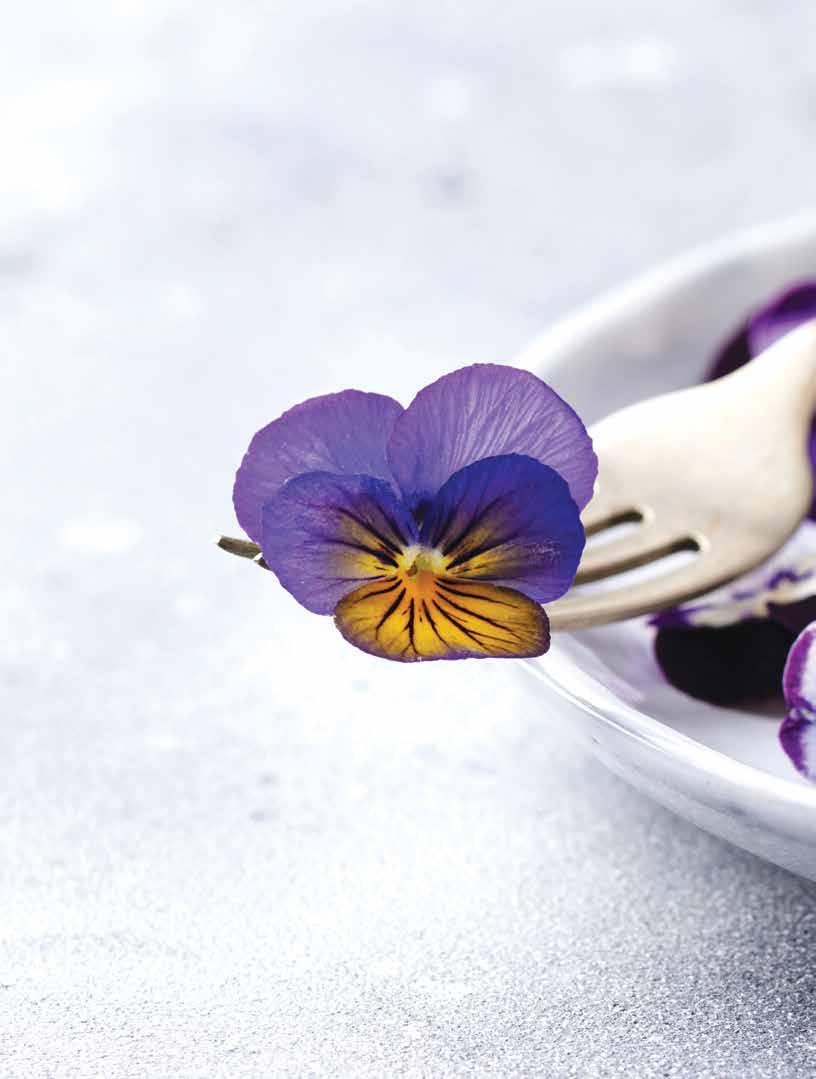
dible flowers make our plates beautiful and enticing, but they’re more than just pretty faces. Although they make excellent decorations for any dish, they can also up the health quotient of your meal when incorporated into the recipe.
They can also be used in myriad ways to add interest and elegance to dishes while imparting health benefits from vitamin C, cancer-preventing phytochemicals, and inflammation-reducing anthocyanins.
Whether you find them in your own garden or at the farmers’ market, make sure you’re using edible flowers that are grown specifically for eating. Avoid ornamental flower nurseries and seek out a reputable edible flower grower; ask them how they treat flowers to make sure they’re not sprayed or treated with chemicals of any kind. While “found” flowers can be both beautiful and tempting, leave them for looking at, unless you’re sure of their origins.
These four recipes will help you create not only pretty plates but delectable meals, perfectly suited for summer eating.
RECIPES HELENA M c MURDO | FOOD STYLING CHELSEA GOUGH | PHOTOS SCOTT YAVIS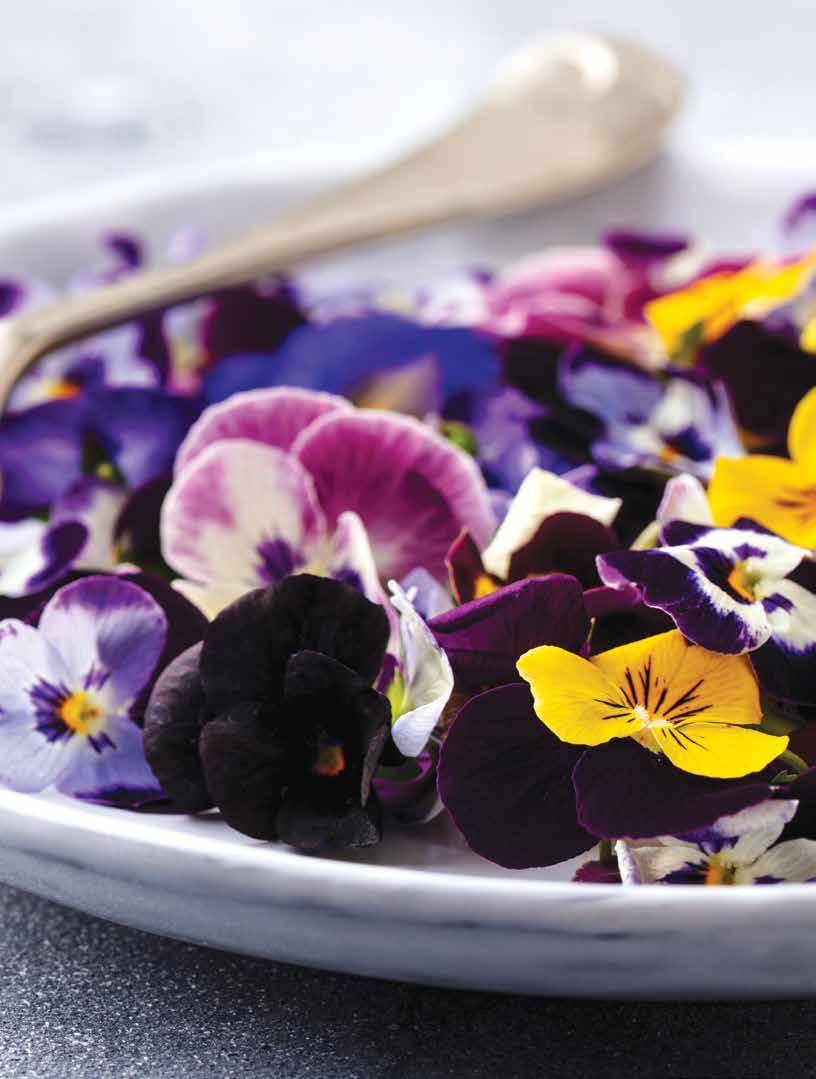

“DESPITE
THE BLUE, PINK, AND PURPLE HUES OF BACHELOR’S BUTTONS, ALSO KNOWN AS CORNFLOWERS, THEIR FLAVOUR IS FRESH AND GREEN.”
Pretty on the plate, this salad of delicate greens contains bright, juicy, tart sorrel; crisp radish; and delicate bachelor’s buttons. Despite the blue, pink, and purple hues of bachelor’s buttons, also known as cornflowers, their flavour is fresh and green. The dressing comes together with a bachelor’s button vinegar made in advance by infusing the flower heads into apple cider vinegar for a bright, subtly sweet flavour. If you can’t find bachelor’s buttons, you can use nasturtium or violas.
SERVES 6
BACHELOR’S BUTTON VINEGAR
8 to 10 bachelor’s button flower heads
1/3 cup (80 mL) apple cider vinegar
1 Tbsp (15 mL) Bachelor’s Button Vinegar
2 Tbsp (30 mL) extra-virgin olive oil
1 tsp (5 mL) honey or maple syrup
20 young asparagus spears
5 oz (140 g) mixed seasonal baby greens
10 to 15 sorrel leaves (optional)
1 cup (250 mL) sliced radish
1 cup (250 mL) snap peas
15 to 20 bachelor’s buttons or other edible flowers such as violas, for garnish
1. For Bachelor’s Button Vinegar, in Mason jar, combine bachelor’s buttons and vinegar. Close lid and store in a cool, dark place for 24 hours.
2. For dressing, in small Mason jar, combine 1 Tbsp (15 mL) of Bachelor’s Button Vinegar with olive oil and honey. Shake well and set aside.
3. In large pot of boiling water, blanch asparagus spears for 2 minutes and remove to large bowl of ice water to stop the cooking process. Drain and dry thoroughly. Cut each spear into 2 inch (5 cm) pieces.
4. In large bowl, combine greens, sorrel (if using), radish, snap peas, and dressing. Arrange on large platter with asparagus, strewing bachelor’s button flowers overtop.
Each serving contains: 121 calories; 4 g protein; 7 g total fat (1 g sat. fat); 12 g total carbohydrates (5 g sugars, 4 g fibre); 25 mg sodium
While many take cornflower or bachelor’s button tea to treat all sorts of ailments, from fever and constipation to chest congestion and menstrual disorders, there isn’t enough scientific evidence to say whether these are effective. What we do know is that their intense blue colour is due to a pigment called protocyanin that may help reduce inflammation in the body, which in turn has powerful effects on health.
When the heat of summer has you ready to wilt, this refreshing summer gazpacho with watermelon, tomatoes, and almond is guaranteed to cool you down. Marigold petals are used to make a slightly spicy, peppery oil with mild notes of citrus; it’s used in the soup and as a beautiful edible garnish. Avoid the bases or “heels” of marigold flowers, as they can be quite bitter.
SERVES 6
10 marigold or calendula flowers
1/4 cup + 2 Tbsp (60 mL + 30 mL) extra-virgin olive oil, divided
15 oz (425 g) very ripe tomatoes (about 2 to 3 large)
2 inch (5 cm) piece of dry baguette, crust removed
1/2 small red onion
1/4 cup (60 mL) almond flour
2 tsp (10 mL) sherry vinegar
1/2 cup (125 mL) cold water
1/2 tsp (2 mL) salt
1/4 tsp (1 mL) pepper
13 oz (370 g) watermelon, about
3 cups (750 mL) diced Marigold blossoms, for garnish
1. Pull petals from marigold flowers; snip off and discard white ends. Place petals in small saucepan with 1/4 cup (60 mL) olive oil. Warm gently on low for 5 minutes. Remove from heat and allow oil to cool completely.
2. Once cool, blend oil in food processor on low speed to chop marigold leaves. Into Mason jar, pour marigold oil, close lid, and set aside in a cool, dark place overnight.
3. In medium-sized bowl, combine tomatoes, baguette, onion, 2 Tbsp (30 mL) olive oil, 2 Tbsp (30 mL) marigold oil, almond flour, vinegar, water, salt, and pepper. Allow to stand at room temperature for 30 minutes, stirring occasionally.
4. Into blender container, pour contents of bowl and purée. Add watermelon and blend on highest speed until smooth. Pour into individual serving glasses; garnish with a few drops of remaining marigold oil and a few marigold blossoms.
Each serving contains: 176 calories; 2 g protein; 15 g total fat (2 g sat. fat); 12 g total carbohydrates (6 g sugars, 2 g fibre); 233 mg sodium
Marigolds can refer to plants from the aster (Asteraceae) family, either from the genus Tagetes or from Calendula officinalis , known as calendula, which often goes by the name pot marigold. Note that not all species of marigolds are edible, so make sure you’re selecting an edible variety from a reputable source. Marigolds contain carotenoids, yellow pigments that support the body’s immune system, and lutein, also a carotenoid, that assists with eye health.

“MARIGOLD PETALS ARE USED TO MAKE A SLIGHTLY SPICY, PEPPERY OIL WITH MILD NOTES OF CITRUS; IT’S USED IN THE SOUP AND AS A BEAUTIFUL EDIBLE GARNISH.”
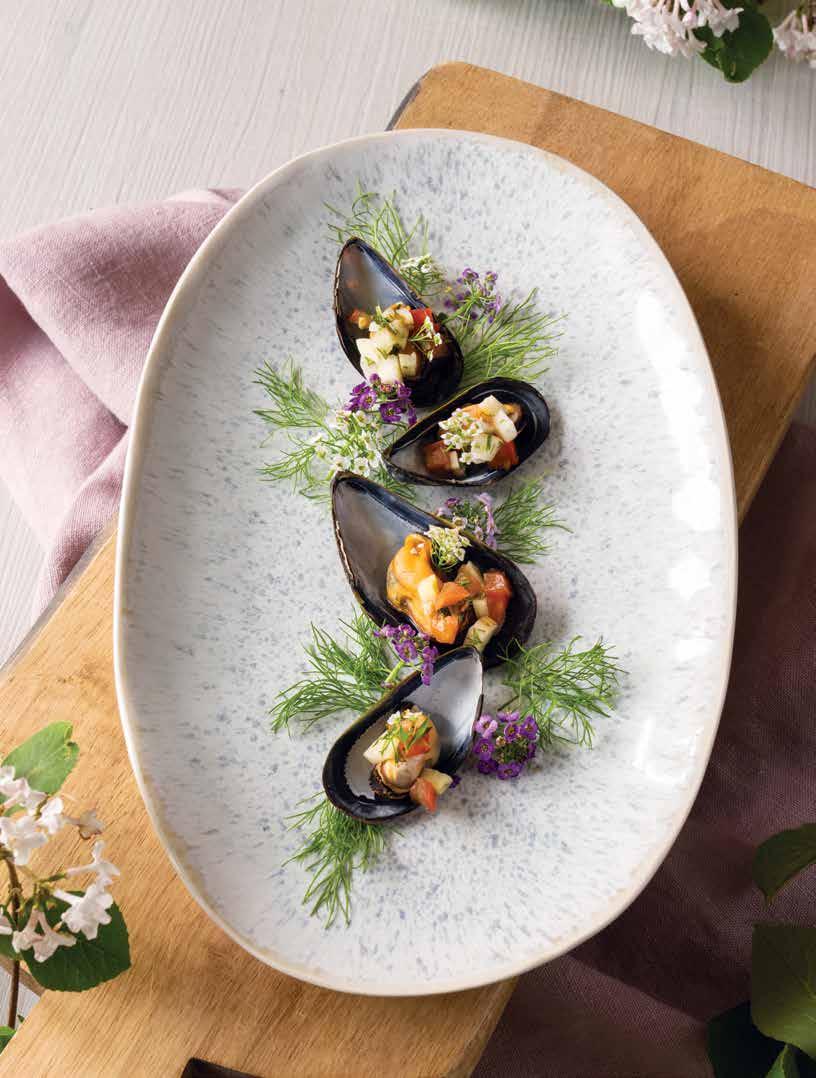
“ALYSSUM HAS A PEPPERY, ANISE-LIKE FLAVOUR AND LIKE FENNEL, PAIRS WELL WITH TOMATOES.”
These mussels make an elegant and alluring cold appetizer that will stretch to feed a crowd. The classic combination of fennel and tomatoes is enlivened with a floral vinegar, prepared in advance. Alyssum has a peppery, aniselike flavour and, like fennel, pairs well with tomatoes.
SERVES 8
FLORAL VINEGAR
8 to 10 mixed edible flower heads, such as marigold, calendula, viola, bachelor’s buttons, and alyssum
1/3 cup (80 mL) apple cider vinegar
1/2 cup (125 mL) very finely diced fennel (reserve stalks)
1/2 cup (125 mL) very finely diced tomato
1 tsp (5 mL) extra-virgin olive oil
2 Tbsp (30 mL) Floral Vinegar
1 Tbsp (15 mL) fennel fronds
2 tsp (10 mL) chopped mint
1/4 tsp (1 mL) salt
1/2 tsp (2 mL) black pepper
1 lb (450 g) mussels, scrubbed, beards removed
20 to 30 alyssum flower sprigs, for garnish
1. For Floral Vinegar, in Mason jar, combine edible flowers and vinegar. Close lid and store in a cool, dark place for 24 hours.
2. Combine fennel, tomato, olive oil, 2 tbsp (30 ml) Floral Vinegar, fennel fronds, and mint. Season with salt and pepper and set aside to allow flavours to meld while you prepare mussels.
3. In large pot, place reserved fennel stalks and 8 cups (2 L) boiling water. Add mussels, cover, and steam for 1 to 2 minutes until shells have opened. Using large, slotted spoon, remove mussels to large plate or bowl. Discard any mussels that do not open.
4. Remove one side of shell of each mussel and top the shell containing the meat with tomato fennel relish. Place on large serving platter and garnish each mussel with a sprig of alyssum.
Each serving contains: 118 calories; 14 g protein; 4 g total fat (1 g sat. fat); 6 g total carbohydrates (1 g sugars, 1 g fibre); 479 mg sodium
Alyssum is related to the cabbage family Brassiceae, so you might also substitute kale flowers in this recipe. Brassicas have been shown to have a positive role in the prevention of cancer.
Many edible flowers have a history of use in traditional medicine that goes back thousands of years. Here are just a few examples.
Commonly taken as tea to treat stomach upset, camomile is mentioned in ancient medical texts from Egypt, Greece, and Rome.
Today used mostly in topical preparations such as ointments and creams to soothe skin conditions and heal burns and cuts, calendula has traditionally been used as well to make teas to be applied topically or taken by mouth to aid digestion and sore throats.
Dandelion has a history of use among many cultures. North American Indigenous peoples used it to treat stomach ailments, heartburn, and skin problems. It’s used in traditional Chinese medicine for these ailments as well as to increase lactation.
Many flowers have been used traditionally to make teas. Hibiscus steeped in a tea has been used traditionally for lowering blood pressure, while licorice mint or hyssop is used as a tea to lessen cold and flu symptoms. Traditional Chinese medicine practitioners use rose tea to combat issues relating to digestion, sleep, mood, and menstrual symptoms. As with many flowers that are used traditionally, more study is required to understand the mechanism by which they work.
The simplicity of this layered dessert hides its deeper and more complex aromatic flavours. A cherry compote subtly scented with rose makes an exquisite combination with cardamom yogurt and a topping of ground pistachios and dried rose petals. When buying rose petals, look for dried ones grown for edible use.
4
PISTACHIO ROSE CRUMBLE
1/4 cup (60 mL) raw, shelled pistachios
2 Tbsp (30 mL) dried rose petals, grown for culinary use
CHERRY ROSE COMPOTE
15 oz (425 g) cherries, about 3 cups (750 mL)
4 tsp (20 mL) honey
4 tsp (20 mL) dried rose petals, grown for culinary use
CARDAMOM YOGURT
2 cups (500 mL) plain Greek yogurt or nondairy yogurt
1 tsp (5 mL) cardamom
2 tsp (10 mL) honey
1. For Pistachio Rose Crumble, place pistachios in bowl of food processor and give one or two quick pulses to break them up. Add rose petals and continue pulsing until you have large bread crumb-sized pieces. Set aside.
2. For Cherry Rose Compote, pit and slice cherries in half; place in medium-sized saucepan with honey. Heat on medium for about 5 minutes, or until juices have released and are hot and bubbling. In small bowl, place rose petals and strain released hot cherry juices overtop. Reserve cherries: return them to saucepan and set aside. Allow petals to infuse in hot cherry juice for about 5 minutes. Taste every so often to see how the flavour is developing and adjust timing as necessary. Strain juice back into saucepan of cherries and discard petals. Pack into glass container; cover and chill.
3. Combine yogurt with cardamom and honey; chill.
4. When ready to serve, divide mixture among 4 glasses, layering half of Cherry Rose Compote, Cardamom Yogurt, and Pistachio Rose Crumble in each; repeat a second time.
Each serving contains: 198 calories; 14 g protein; 3 g total fat (2 g sat. fat); 31 g total carbohydrates (28 g sugars, 3 g fibre); 48 mg sodium
Rose petals are full of polyphenols, which are powerful antioxidant compounds that can help prevent cell damage. Rose petals and rose hips contain high levels of vitamin C, which supports our immune function. Rose petal tea also contains vitamin E, which, when taken with vitamin C, assists in maintaining healthy skin. It’s also thought that the simple aroma of rose can act to promote a relaxed mood.
“A CHERRY COMPOTE SUBTLY SCENTED WITH ROSE MAKES AN EXQUISITE COMBINATION WITH CARDAMOM YOGURT AND A TOPPING OF GROUND PISTACHIOS AND DRIED ROSE PETALS.”

Flowers as supplements
PASSION FLOWER
Passiflora incarnata ; climbing vine
may help prevent anxiety and insomnia; more study required
ST. JOHN’S WORT
Hypericum perforatum; long used in European traditional medicine
shown to be effective in the treatment of mild to moderate depression; may be beneficial for menopausal symptoms but more evidence required
ECHINACEA
Echinacea purpurea; also known as purple coneflower
studies show it may prevent acquisition of common cold
MILK THISTLE
Silybum marianum; flowering herb related to ragweed
primarily used to aid problems with liver and gallbladder

EACH YEAR, BEGINNING IN LATE SPRING until the fall, nature rewards us with an array of sweet and delicious berries in an assortment of beautiful hues of yellow, orange, red, blue, and black. Found on backyard bushes, at local farmers’ markets, or growing wild in nature (if you’re fortunate to find them), summer berries are bountiful, beautiful, and delicious, with flavour and sweetness that by far surpass their transported-in counterparts of winter months!
More than just a pretty snack, berries are a nutrient powerhouse full of fibre, high in vitamins and minerals, and packed with antioxidants such as anthocyanins, resveratrol, and ellagic acid. With a sustainable and local abundance of delicious berries at our doorstep, how could these delectable gems not be a daily staple all summer long?
RECIPES SUSAN ROSSIT, RHN | FOOD STYLING BRUCE NOLLERT | PHOTOS SCOTT YAVIS
“THICK
AND CREAMY, THIS TANGY BOWL OF GOODNESS IS HIGH IN PROTEIN AND FIBRE AND A PERFECT WAY TO INCLUDE BERRIES AT BREAKFAST.”
This smoothie bowl is not just for smoothie lovers! Thick and creamy, this tangy bowl of goodness is high in protein and fibre and a perfect way to include berries at breakfast. Sweetened with banana and completely customizable, top it with your favourite nuts and seeds to help you stay energized. Try adding a teaspoon of beetroot powder when blending and watch the colour pop!
1 cup (250 mL) raspberries (heaping)
1 frozen medium banana, cut into 4 pieces before freezing
1/2 cup (125 mL) oat-based plain Greek-style yogurt (or Greek yogurt of choice)
1/3 cup (80 mL) baby spinach leaves
1/4 cup (60 mL) unsweetened almond milk
1 Tbsp (15 mL) hemp hearts
1 tsp (5 mL) ground flaxseed
1 inch (2.5 cm) piece gingerroot, peeled
1. To high-speed blender, add raspberries, banana, yogurt, spinach, almond milk, hemp hearts, flaxseed, and gingerroot.
2. Blend ingredients on medium to high speed until creamy. Pour into bowl, add toppings of choice, and enjoy!
Each serving contains: 380 calories; 16 g protein; 11 g total fat (2 g sat. fat); 59 g total carbohydrates (25 g sugar, 15 g fibre); 119 mg sodium
Adding toppings to your smoothie bowl adds colour and texture, and also increases nutrients and fibre, while encouraging digestion by chewing! Try adding one, or a combo, of any of the following.
fresh fruit granola
slivered or chopped nuts
pumpkin seeds chia seeds
ground flaxseed hemp hearts unsweetened shredded coconut or coconut ribbons
Seasonal berries
Check this guide for the best times to find berries and how to keep them fresh for longer.
MAY salmonberries
JUNE salmonberries, saskatoon berries, strawberries
JULY blackberries, black currants, blueberries, boysenberries, gooseberries, huckleberries, raspberries, red currants, saskatoon berries, strawberries, tayberries
AUGUST blackberries, blueberries, elderberries, goji berries, gooseberries, huckleberries, mulberries, raspberries
SEPTEMBER cranberries, elderberries
OCTOBER cranberries
NOVEMBER cranberries
A fruity spinach salad spinoff tops a hearty crostata packed full of juicy and sweet roasted summer strawberries. Served warm or cold, this beautiful rustic tart is plenty sophisticated for any afternoon brunch. In a pinch, you could substitute frozen pie dough to make the crust.
SERVES 6 TO 8
CRUST
2 organic eggs, divided
3 Tbsp (45 ml) ice cold water
3/4 cup (180 mL) all-purpose flour
3/4 cup (180 mL) stoneground spelt flour
1/2 tsp (2 mL) sea salt
1/2 cup (125 mL) salted butter, cut into 3/4 in (1.5 cm) cubes, cold
FILLING
4 cups (1 L) sliced strawberries
2 Tbsp (30 mL) arrowroot powder
1 Tbsp (15 mL) balsamic glaze
1 Tbsp (15 mL) honey
TOPPING
1/4 cup (60 mL) balsamic glaze
2 Tbsp (30 mL) extra-virgin olive oil
1 tsp (5 mL) Dijon mustard
4 cups (1 L) baby spinach leaves
1/3 cup (80 mL) thinly sliced red onion
1/2 cup (125 mL) chopped toasted pecans
1/3 cup (80 mL) crumbled goat cheese
1. Whisk 1 egg and ice water together and set aside.
2. In food processor with steel blade, add flours, salt, and cubed butter. Coat cubed butter in flour and then pulse 10 to 15 times, until mixture resembles bread crumbs. Continue pulsing while adding egg and water mixture through feed tube, until mixture is combined and before it forms a ball. Empty dough onto beeswax wrap and shape into round disk about 5 inch (10 cm) round, wrap tightly in beeswax wrap and refrigerate for 45 minutes to 1 hour.
3. Remove dough from fridge and let rest for 10 minutes.
4. Preheat oven to 350 F (180 C) and place large baking sheet on middle oven rack to preheat.
5. While dough rests, make filling. In large bowl, toss strawberries with arrowroot powder, 1 Tbsp (15 mL) balsamic glaze, and honey, and set aside.
6. For easy cleanup, place dough centred on parchment-lined counter or surface and cover with another sheet of parchment paper. Roll dough out from centre and around in a circle, leaning against the top and bottom layers of parchment paper and the counter edge to keep it in place. Continue rolling until dough is even in thickness and 12 inch (24 cm) in diameter.
7. With slotted spoon, spread strawberry filling evenly onto middle of dough, leaving a 1 1/2 inch (3 cm) border. Discard remaining liquid in bowl.
8. Gently roll dough border up at edges to enclose strawberries, pleating dough to make a circle. In small bowl, whisk remaining egg and, with pastry brush, gently brush onto pleated dough border. Carefully transfer strawberry-filled crostata and bottom parchment paper onto heated baking sheet. Bake on middle oven rack until golden brown, approximately 35 to 40 minutes. Transfer crostata to cooling rack and let sit for 15 minutes, until juices solidify.
9. For topping, in large bowl, whisk together 1/4 cup (60 mL) balsamic glaze, olive oil, and Dijon mustard, and toss with spinach, red onion, pecans, and goat cheese. Top crostata and serve.
Each serving contains: 390 calories; 9 g protein; 26 g total fat (11 g sat. fat); 32 g total carbohydrates (9 g sugar, 4 g fibre); 272 mg sodium
“A FRUITY SPINACH SALAD SPINOFF TOPS A HEARTY CROSTATA PACKED FULL OF JUICY AND SWEET ROASTED SUMMER STRAWBERRIES”
1 cup (250 mL) balsamic vinegar
3/4 cup (180 mL)
diced strawberries
1/4 cup (60 mL)
honey
1 tsp (5 mL) grated lemon zest
Sea salt, to taste

1. In small saucepan, bring all ingredients to a boil over medium heat while mashing strawberries with fork against edge of pot. Reduce heat and simmer until reduced by half, approximately 8 to 10 minutes. Strain and refrigerate for up to a week in covered glass jar.
Each serving contains: 57 calories; 0 g protein; 0 g total fat (2 g sat. fat); 14 g total carbohydrates (14 g sugar, 0 g fibre); 3 mg sodium

“SERVE WITH A SALAD OF MIXED GREENS, AND THESE SALSA AND SKEWERS ARE TRANSFORMED INTO AN EYE-PLEASING MEAL THAT IS FLAVOUR FILLED AND DELICIOUS!”
Bright and vibrant, golden berries give this fruity salsa fresca a tart and tangy crunch that pairs well with mango. Serve with a salad of mixed greens, and these salsa and skewers are transformed into an eyepleasing meal that is flavour filled and delicious! With the firm texture of golden berries in the salsa and marinated chicken, this is a perfect meal to prep the day ahead and enjoy!
SERVES 6
12 bamboo skewers
1/2 cup (125 mL) extra-virgin olive oil
3 garlic cloves, peeled and minced
1 Tbsp (15 mL) ground cumin
1 1/2 tsp (7 mL) chili powder
1 tsp (5 mL) dried basil
1 tsp (5 mL) dried thyme
1/4 tsp (2 mL) sea salt
4 boneless chicken breasts
SALSA FRESCA
1 cup (250 mL) quartered golden berries
1/3 cup (80 mL) diced mango
2 Tbsp (30 mL) finely diced red onion
2 Tbsp (30 mL) finely chopped cilantro
1 Tbsp (15 mL) finely diced jalapeno
1 Tbsp (15 mL) lime juice
1 garlic clove, peeled and crushed
Salt and pepper, to taste
1. To keep bamboo skewers from scorching, soak them in water for about 1 hour before use.
2. In small bowl, whisk olive oil, garlic, cumin, chili powder, basil, thyme, and salt together, and set aside.
3. Place chicken breasts between 2 layers of parchment paper and, with flat side of a meat mallet or rolling pin, gently pound until 1/4 inch (1 cm) thick. Cut each pounded chicken breast lengthwise into 3 equal strips and place with marinade into sealable bag or container. Marinate in refrigerator for at least 2 hours.
4. In small bowl, toss golden berries with mango, red onion, cilantro, jalapeno, lime juice, and garlic. Add salt and pepper to taste.
5. Remove chicken from fridge and thread each piece of chicken onto a bamboo skewer. Preheat barbecue and cook chicken skewers on medium heat, turning often until cooked through, approximately 10 to 15 minutes.
6. Remove chicken skewers from barbecue, top with golden berry salsa fresca, and serve.
Each serving contains: 345 calories; 19 g protein; 20 g total fat (2 g sat. fat); 26 g total carbohydrates (14 g sugar, 11 g fibre); 115 mg sodium
Golden berries are also known as Inca berries, Cape gooseberries, physalis, or Peruvian ground cherries. Although they flourish in a warm climate and grow well in a greenhouse, these papery-husked tart berries have found their way north and can adapt well outdoors. Golden berries are part of the nightshade family and contain solanine when unripe. Solanine is a toxic metabolite that can cause digestive upset. Be sure to eat golden berries only when they are fully ripe (or dried) and eat in moderation.
So smooth, so rich, and so creamy, you’ll find it hard to believe it’s not dairy! Toasted hazelnuts and coconut are bound together by sweet dates, creating the perfect nutty and gluten-free base that’s then topped with a dreamy layer of tangy blackberry decadence. These bars are easy to make and store well in the freezer for up to a week. Enjoy at room temperature or frozen—they’re delicious either way!
SERVES 16
BASE
1 cup (250 mL) raw hazelnuts
1 cup (250 mL) Medjool dates, pitted
1/4 cup (60 mL) unsweetened shredded coconut
1/4 tsp (1 mL) sea salt
VEGAN CHEESECAKE LAYER
1 1/2 cups (350 mL) raw cashews
1 1/4 cups (310 mL) blackberries, divided
3/4 cup (180 mL) full-fat coconut milk, the creamiest top of the can
1/2 cup (125 mL) lemon juice
1/3 cup (80 mL) maple syrup
4 Tbsp (60 mL) melted coconut oil, cooled
1. Quick-soak cashews: bring 2 1/2 cups (625 mL) water to boil in medium saucepan. When boiling, add cashews, cover with lid, and turn off heat. Let soak for 30 minutes and then rinse with cold water.
2. Preheat oven to 350 F (180 C).
3. Place hazelnuts on parchment paper-lined baking sheet and roast in preheated oven for 10 to 15 minutes, stirring halfway through, until golden brown and fragrant. Set aside to cool. As hazelnut skins are often bitter, when cooled, place toasted hazelnuts in clean dish towel and rub vigorously to remove skins.
4. Line 8 x 8 inch (16 x 16 cm) baking dish with parchment paper 8 inch (16 cm) one way and 8 in (16 cm) the other way, leaving enough at the top to grab and remove cheesecake bars from dish when done.
5. In food processor, pulse toasted hazelnuts until texture of finely
chopped nuts. Add dates, coconut, and salt; pulse until well combined. Press hazelnut mixture into base of parchment paper-lined baking dish to make an even layer and set in freezer to firm up.
6. To high-speed blender, add soaked and rinsed cashews, 1/2 cup (125 mL) blackberries, coconut milk, lemon juice, maple syrup, and coconut oil. Blend until smooth. Pour onto base layer and top with remaining 3/4 cup (180 mL) blackberries. Freeze for 4 to 6 hours.
7. Remove from freezer and let sit out for 10 to 15 minutes before pulling parchment up to remove cheesecake from baking dish. Cut into 2 inch (5 cm) bars and store in sealed container in freezer. Enjoy frozen or let sit for 1 hour before eating.
Each serving contains: 218 calories; 4 g protein; 15 g total fat (7 g sat. fat); 20 g total carbohydrates (13 g sugar, 3 g fibre); 37 mg sodium
loaded with antioxidants (such as vitamins A, E, and C; anthocyanins; resveratrol; and ellagic acid) that combat free radicals and protect our cells
contain antiinflammatory properties
may reduce cardiovascular risk and lower LDL (bad) cholesterol levels may improve blood sugar and insulin levels
rich in vitamins and minerals and low in calories
high in fibre and beneficial for digestion
benefit skin and may help prevent aging and damage due to sun exposure
may contain cancer-fighting properties
“SO SMOOTH, SO RICH, AND SO CREAMY, YOU’LL FIND IT HARD TO BELIEVE IT’S NOT DAIRY!”

MIX IT UP
This recipe is just as delicious with other in-season summer beries. Try substituting the berries and base layer nuts with the following combinations:
RASPBERRIES WITH WALNUTS
STRAWBERRIES WITH ALMONDS
BLUEBERRIES WITH WALNUTS
FAST AND FRESH SUMMERTIME RECIPES

LET’S BRING the refreshing flavour of mint into the kitchen this summer. Too often, fresh mint is overlooked as a starring ingredient and is instead allocated to the role of decorative garnish or a partner to chocolate or fruit in desserts. With its distinctive flavour profile and heady aroma, mint is the perfect herb to incorporate into a variety of fresh, summery dishes.
RECIPES LAWREN MONETA FOOD STYLING BRUCE NOLLERT PHOTOS SCOTT YAVISGrilling is a great way to boost the flavour and sweetness of fruits; heat caramelizes the naturally occurring sugars. For this recipe, sun-kissed peaches are used; however, other fruits such as pineapple, mango, nectarine, or plums would work equally well. Paired with a refreshing minty pesto sauce, this speedy dessert is sure to be a hit at your next barbecue.
2 cups (500 mL) packed fresh mint leaves
4 Tbsp (60 mL) grapeseed oil, divided
2 Tbsp (30 mL) extra-virgin olive oil
1/4 cup (60 mL) raw pine nuts, raw cashews, or raw sunflower seeds
2 Tbsp (30 mL) mild raw honey, such as clover honey
1 tsp (5 mL) vanilla extract
Pinch of fine sea salt
4 ripe peaches
Your favourite vanilla ice cream, to serve, if desired
1. Preheat barbecue grill to medium-high.
2. While barbecue preheats, make mint pesto sauce. In blender, place mint, 3 Tbsp (45 mL) grapeseed oil, olive oil, pine nuts, honey, vanilla, and salt. Blend, scraping down sides of blender jug as needed with rubber spatula, until pesto is mostly smooth, about 30 seconds. If pesto is too thick, thin with water, adding 1 Tbsp (15 mL) at a time until desired consistency is achieved.
3. Cut peaches or your chosen fruit in half and discard pits. Rub cut side of fruit with some of the remaining 1 Tbsp (15 mL) grapeseed oil. Place fruit cut-side down on preheated grill and cook, moving as needed so fruit does not burn, until warm and grill marked, about 2 minutes.
4. To serve, divide grilled fruit among serving bowls and top with some mint pesto. While delicious just as is, topping with a scoop of ice cream is highly recommended, as it gives the final dish more depth and richness.
Each serving contains: 271 calories; 4 g protein; 19 g total fat (2 g sat. fat); 26 g total carbohydrates (21 g sugars, 5 g fibre); 70 mg sodium
Any leftover mint pesto sauce makes an amazing fruit dip. Stir pesto together with yogurt of choice. No need for measurements; just mix together to taste and serve with an array of sliced summer fruit for dunking.
“PAIRED WITH A REFRESHING MINTY PESTO SAUCE, THIS SPEEDY DESSERT IS SURE TO BE A HIT AT YOUR NEXT BARBECUE.”
This vibrant summer salad works equally great as a side dish or light lunch. It also travels well, should the urge to eat al fresco strike. Leftovers keep well refrigerated for a few days.
SERVES 5
2 Tbsp (30 mL) unseasoned rice vinegar
2 Tbsp (30 mL) fish sauce
1 Tbsp (15 mL) liquid clover honey
1 Tbsp (15 mL) water
1 tsp (5 mL) sambal oelek or 1 finely chopped bird’s eye chili
1 Tbsp + 1/3 cup
(15 mL + 80 mL) loosely packed mint leaves, divided
1 cup (250 mL) snow peas, ends trimmed
1 cup (250 mL) bean sprouts
5 1/2 oz (150 g) rice vermicelli noodles
1 cup (250 mL) halved cherry tomatoes
14 oz (400 g) watermelon, cut into bite-sized pieces
1/4 cup (60 mL) loosely packed Thai basil leaves or regular basil leaves
2 green onions, thinly sliced
2 Tbsp (30 mL) roughly chopped toasted peanuts (optional)
1 lime, cut into wedges for serving
1. In small bowl, whisk together rice vinegar, fish sauce, honey, water, and sambal oelek or chopped chili until well combined. Finely chop 1 Tbsp (15 mL) mint leaves and stir into dressing. Set aside while preparing salad, or transfer to airtight container and refrigerate for up to 1 week.
2. Bring large saucepan of water to boil over high heat. While water is coming to a boil, prepare ice bath by placing a couple of handfuls of ice into large bowl and covering with cold water. Set aside.
3. Blanch snow peas in boiling water for 10 seconds. Using slotted spoon, transfer to ice bath for 1 minute before placing on clean kitchen towel to drain. Repeat blanching and ice water bath treatment with bean sprouts, taking care to blanch bean sprouts in boiling water for only 5 seconds. Place bean sprouts to drain on clean kitchen towel alongside snow peas.
4. Cook rice noodles according to package instructions and place in large bowl. Add about half the reserved dressing and toss to combine.
5. Cut snow peas into bite-sized pieces and add to bowl with noodles along with bean sprouts, cherry tomato halves, watermelon pieces, torn basil leaves, green onion, and remaining 1/3 cup (80 mL) torn mint leaves. Drizzle with remaining dressing before gently tossing all together. Pile onto serving plates and garnish with a sprinkling of chopped peanuts, if using, and lime wedges.
Each serving contains: 215 calories; 6 g protein; 2 g total fat (0 g sat. fat); 45 g total carbohydrates (11 g sugars, 4 g fibre); 590 mg sodium
Sambal is an Indonesian condiment that is made up of fresh and dried ground spices and herbs. Just like chutney in India or salsa in Mexico, there are countless variations of sambals all across Indonesia. In North America, we typically find a sambal called sambal oelek on our grocery shelves.
“THIS
VIBRANT SUMMER SALAD ALSO TRAVELS WELL, SHOULD THE URGE TO EAT AL FRESCO STRIKE.”

To make this salad more of a complete meal, add whatever protein you have on hand. Shredded roast chicken, sautéed prawns, or grilled tofu all make wonderful
A serving of half a medium avocado has more potassium than a medium banana.

“THE SWEET MANGO AND ZIPPY MINT ADD AN EXTRA PUNCH OF FLAVOUR TO THIS GUACAMOLE-INSPIRED DIP.”
Sweet mango and zippy mint add an extra punch of flavour to this guacamole-inspired dip. Avocados, which are the backbone of guacamole, contain a good amount of healthy polyunsaturated and monounsaturated fats, which help boost metabolism and keep you feeling fuller for longer.
SERVES 4
1 medium shallot, finely diced
2 Tbsp (30 mL) freshly squeezed lime juice
1/2 tsp (2 mL) kosher salt
2 ripe large avocados
1/4 cup (60 mL) packed fresh cilantro, chopped
1/4 cup (60 mL) packed fresh mint, chopped, plus extra for garnish
1 serrano chili, finely diced, seeds removed if you don’t like too much spice
1 Ataulfo mango, peeled, pitted, and diced
1 green onion, thinly sliced
1. In large bowl, stir together shallot, lime juice, and salt. Set aside for 5 to 10 minutes.
2. Halve avocados, discard pit, scoop out flesh, and add to bowl along with marinated shallots. Mash with fork until you get a creamy dip, the consistency that you like. Fold in cilantro, mint, serrano chili, and 3/4 of the mango. Let sit for 10 minutes at room temperature before garnishing with extra torn mint leaves, remaining diced mango, and a sprinkling of green onion. Serve alongside jicama sticks or pita chips, if desired.
Each serving contains: 183 calories; 2 g protein; 13 g total fat (2 g sat. fat); 17 g total carbohydrates (7 g sugars, 7 g fibre); 397 mg sodium
When looking for a perfectly ripe avocado, choose one that has dark green or almost black skin. When squeezed, you should feel it yield to pressure. If you’re not planning to eat your avocado for a few days, try choosing one that is unripe (an unripe avocado will feel very firm) and leaving it at room temperature. Avocados are climacteric fruit, which means they will continue to ripen after harvesting.
While spearmint and peppermint are the most common varieties cultivated for culinary use, there are hundreds of mint varieties to choose from should you want to grow your own. Some other varieties of culinary mint include
• apple mint
• chocolate mint
• ginger mint
• grapefruit mint
• banana mint
• Cuban mint
• pineapple mint
Take note that not all mint is meant to be used for culinary preparations. Some are best grown for their aromatic properties or aesthetic appearance, such as Pennyroyal, which is toxic to humans and typically used as an insecticide.
It’s important to note, if you’re thinking of growing mint, that it tends to spread quickly, so either plant in a spot where it’s a benefit (not a drawback) or keep mint plants in containers to control their growth. No matter how you plant it, picking and trimming regularly will ensure plenty of new growth throughout the summer months.
Who wouldn’t want to eat ice cream for breakfast? This cool and creamy concoction only feels like an indulgence. Packed with fibre from bananas, spinach, mint, and oats, this breakfast is sure to keep you feeling full and satisfied until lunchtime.
SERVES 2
1/2 cup (125 mL) plain yogurt or plain coconut yogurt
1/4 cup (60 mL) rolled oats
2/3 cup (160 mL) packed fresh spinach leaves
2/3 cup (160 mL) packed fresh mint leaves, plus extra for garnish
1/2 tsp (2 mL) vanilla extract
3 medium frozen bananas, chopped into 1 inch (2.5 cm) pieces
1 1/2 Tbsp (22 mL) raw cacao nibs, plus extra for garnish
1/2 cup (125 mL) fresh raspberries, for garnish
1. In blender, combine yogurt, rolled oats, spinach, mint, and vanilla until smooth. Add frozen bananas and blend, scraping down sides of blender as needed, until thick and creamy. With blender turned off, fold cacao nibs into smoothie mixture.
2. Divide smoothie into 2 serving bowls. Garnish each bowl with some extra cacao nibs, fresh raspberries, and a few mint leaves. Serve immediately.
Each serving contains: 307 calories; 8 g protein; 6 g total fat (3 g sat. fat); 58 g total carbohydrates (28 g sugars, 10 g fibre); 55 mg sodium
Raw cacao nibs contain several compounds that can increase levels of serotonin and dopamine in your brain, which are generally nicknamed the “feel-good hormones.”
When planning for food on the go, choosing what to transport your food and drinks in is just as important as the menu. Take into consideration these eco-friendly tips the next time you’re taking your meal al fresco.
Consider products that are reusable, lightweight, durable, and easy to clean.
If you don’t want to carry reusable containers, consider containers or cutlery that can be recycled or composted.
To wipe up spills or drips, consider using cloth napkins or bring along a roll of reusable paper towel. A reusable waterproof bag is a great place to stuff soiled linens until you can get home.
Food-grade silicone sandwich or snack bags are a great eco-friendly option in place of single use zip-top plastic bags. They are sturdy and durable but flexible enough to fold up and put in your pocket.
In place of plastic wrap, try beeswax wrappers. They come in a plethora of colourful designs and are great to use as a sandwich wrap. Easy to clean with cold water and a little soap, after drying these wrappers can be used over and over again.
Insulated reusable drinking bottles are sure to keep everything from coffee to lemonade at your ideal temperature for hours.

“WHO WOULDN’T WANT TO EAT ICE CREAM FOR BREAKFAST? THIS COOL AND CREAMY CONCOCTION ONLY FEELS LIKE AN INDULGENCE.”
NATURAL PRODUCTS FOR YOUR HEALTHY LIFE


Floradix Liquid Iron Formula is clinically proven to quickly raise serum ferritin levels (iron levels) in the body, thereby restoring energy and well-being. Formulated for those with low iron or anemia, it is easily absorbed and non-constipating. Naturopath and midwife recommended!
MYHEALTHOLOGY.CA/PRODUCTS/SALUS-FLORADIX
Webber Naturals has combined clinically proven NEM with a standardized turmeric extract to help relieve joint pain and stiffness, reduce inflammation, and prevent oxidative damage to joint tissue. Also includes BioPerine ® black pepper to enhance the body’s absorption and use of turmeric.
WEBBERNATURALS.COM | 1-800-430-7898
Made for your everyday adventure, tentree essentials are just as easy on the planet as they are to wear. From throw-on-and-go dresses (like this one) to super soft shorts and tees, everything is made with responsibly sourced materials. Plus, every piece plants trees.
TENTREE.COM


The highest potency fresh cranberry concentrate available. Every vegetarian capsule provides 600 mg of concentrated (50:1) cranberry extract—the equivalent of 30 g of fresh cranberries! Cranberry contains anti-adhesins that help the body flush out bad bacteria that cause UTIs.
WEBBERNATURALS.COM | 1-800-430-7898














Triple-action, tri-layer tablets for immediate and gradual release
• With
5-HTP and calming L-theanine
• Contains sleep botanicals: valerian, passionflower, and hops
• Promotes falling asleep quickly and improves sleep quality







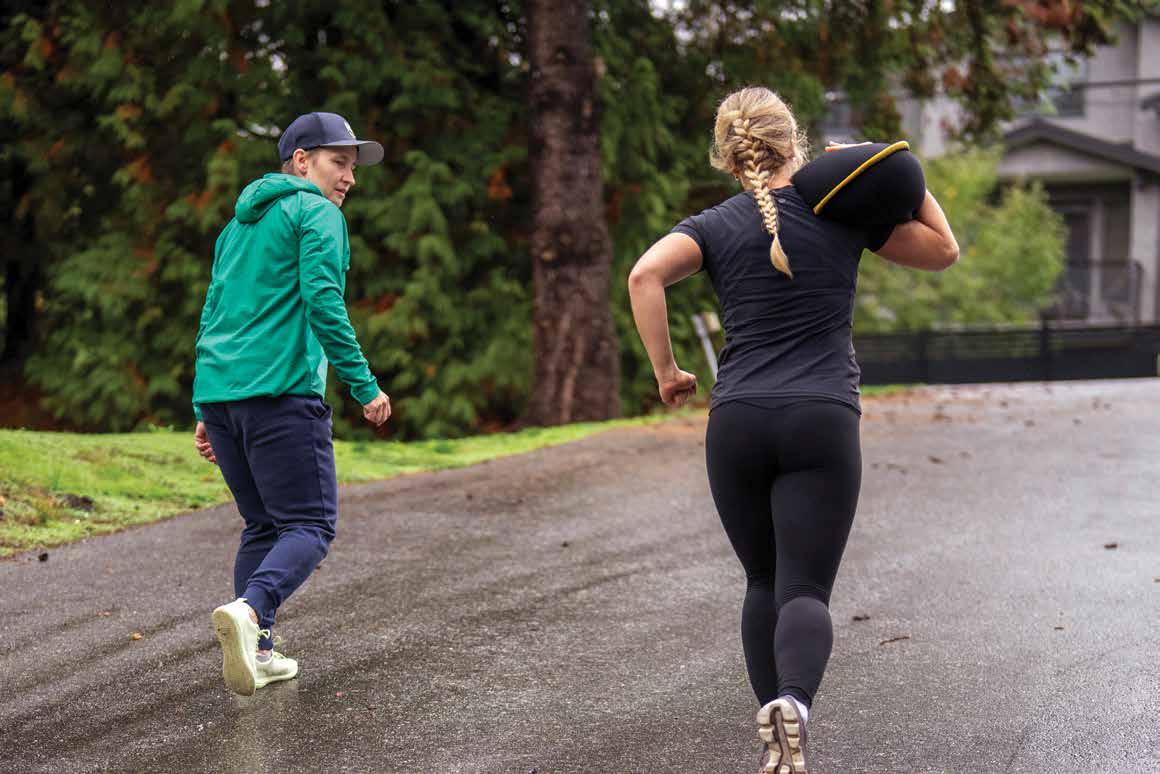
Nurture your passion and change lives with a career in




Here’s a handy roundup of Brain health supports from this issue of sage. Read through this list and make a note of the ones that make sense for you and your family. Then breeze through the grocery store, confident that you’re filling your cart with seriously healthy star power.

Gingko biloba (P. 31 )
May help improve memory function and reduce brain inflammation.

Vitamin B6 (P. 31 )
May help improve symptoms of anxiety and depression.

Mint (P. 52 )
Is thought to potentially relieve digestive issues and reduce stress.

St. John’s wort (P. 41 )
Is shown to be effective in the treatment of mild to moderate depression and may also be beneficial for menopausal symptoms.

Curcumin (P.26)
May help improve brain function and manage dementia, as well as lower the risk of cardiovascular disease.

Omega-3 (P.26) Supplements may improve ADHD symptoms and enhance memory and verbal skills in children.

L-theanine (P.26)
Has been shown to relieve stress disorders, improve mood, and maintain normal sleep.



We hope you enjoyed this issue and found plenty of inspiration for a healthier mind and happier summer. We encourage you to take the time each day to be grateful for all the beauty that summer brings, relishing the wonders of the season.
And while there is so much left of summer to enjoy, we’re also peeking around the corner at our September issue. In the next issue of sage, we’re focusing on the little ones, bringing you tips on how to set the kids in your life up for success in the new school year and beyond.
And, as always, get ready for plenty of tasty recipes that will keep you satiated and inspired all autumn long!
Until then, we wish you a summer full of warm days and even warmer memories.



































































